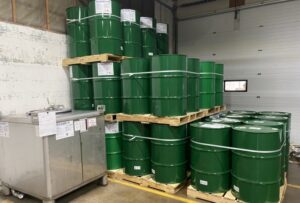Why Vapor Degrease? – Benefits of Vapor Degreasing
Learn more about the many benefits of utilizing vapor degreasing technology for your parts cleaning!
Learn more about the many benefits of utilizing vapor degreasing technology for your parts cleaning!
Here at Enviro Tech International degreasing solvents are all that we do, and thus we understand the importance of a high quality standard for precision cleaning in the manufacturing process. We also understand that much thought goes in to deciding not just what products are selected for use in critical cleaning, but that the methods in which these products are to be used are equally important.

NEXT-HD Pro is a replacement solvent for TCE and PERC. NEXT-HD Pro is Enviro Tech’s newest 1,2 trans blend using no HFC’s. This solvent blend is perfectly suited for vapor degreasing in modern equipment and general cleaning. Its solvency for hydrocarbon soils is superior to most similar high-trans fluorinated solvent blends.
When selecting a parts cleaning method, facility managers must keep many factors in mind. One of the most pressing things to consider is the environmental impact of the method chosen, and the need to remain compliant with environmental protection regulations. However, cost containment is also always an essential consideration when selecting any industrial process.
Solvents are essential for any industrial cleaning application. There are hundreds of different types of solvent cleaners, each with its own characteristics and uses.
Before we discuss these solvent types, let’s first define what a solvent is — a substance (usually a liquid) that can be used to dissolve other materials without chemically changing them. Solvents are classified as inorganic (water is the most common example) or organic. Organic solvents contain carbon and include virtually all of the common industrial metal cleaning solutions.
It can sometimes be difficult to determine exactly which cleaning solvents among all the available choices will best meet your needs. To make an informed choice, it helps to become familiar with the different types of solvent cleaners.
There are three main types of metal cleaning solutions available for use in precision cleaning:
Let’s take a look at their uses and what characterizes each type.
Oxygenated solvents. As their name implies, these solvents contain oxygen in their molecular structure. Derived from petroleum products, they typically have low toxicity and high solvent power.
Oxygenated solvents are widely used as additives in manufacturing a huge variety of products from cosmetics to paint, as well as for cleaning. Many of these applications require a high degree of purity, so specifications for these solvents often focus on levels of impurities, and these products are typically refined to maintain a high level of purity. However, the manufacturing process for these substances is not expensive, so they tend to be relatively affordable.
Examples of oxygenated solvents include alcohols, ethers, esters, glycol ethers, glycol ether esters and ketones.
Hydrocarbon solvents. These are petroleum-based solvents whose chemical structure contains hydrogen and carbon atoms. Hydrocarbon solvents can have complex chemical structures. There are two main types of hydrocarbon solvent, including:
The complex composition of hydrocarbon solvents means they can be formulated to fulfill very specific industrial requirements. It is not uncommon for custom hydrocarbon solvents to be created. Some of the distinguishing factors between different hydrocarbon solvents include flash point, density, distillation range and aroma.
Halogenated solvents. These solvents contain halogen atoms (such as fluorine, bromine, iodine or chlorine) in their molecular structure. Because they are typically stable, non-flammable and fast-evaporating with high solvent capacity, they were widely used in industry for precision cleaning and many other applications. However, many types of halogenated solvents have been or are being phased out for environmental reasons. Some examples include perchloroethylene, chlorinated fluorocarbons, and 1,1,1-trichloroethane. If you are looking for an alternative to a specific type of halogenated solvent, call us to discuss alternatives.
When choosing a metal cleaning solution, you will need to consider a number of factors, including:
Solvent selection can be a complex task. It is important to find the right one for your needs because your choice of solvent can significantly impact performance, product quality, regulatory compliance and profitability.
At Enviro Tech, customer service is our priority. We have been helping companies like yours find the best solutions for their precision cleaning needs since 1994. If you have questions about solvent selection, one of our expert associates will be happy to help. Call us today at 708-249-6501 — or contact us here.
